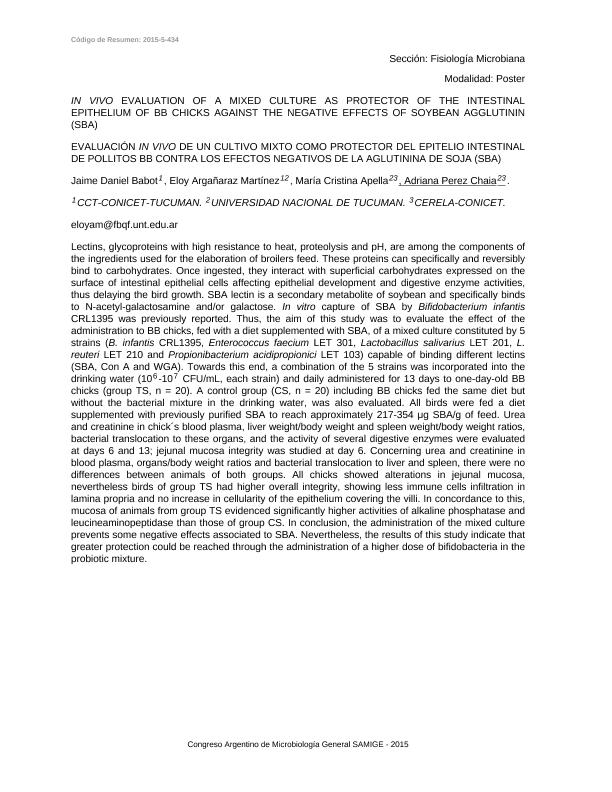Mostrar el registro sencillo del ítem
dc.contributor.author
Babot, Jaime Daniel

dc.contributor.author
Argañaraz Martínez, Eloy
dc.contributor.author
Apella, Maria Cristina

dc.contributor.author
Perez Chaia, Adriana Beatriz

dc.date.available
2023-03-01T15:44:19Z
dc.date.issued
2015
dc.identifier.citation
In vivo evaluation of a mixed culture as protector of the intestinal epithelium of BB chicks against the negative effects of soybean agglutinin (SBA); XI Congreso Argentino de Microbiología General SAMIGE; Córdoba; Argentina; 2015; 1-1
dc.identifier.uri
http://hdl.handle.net/11336/189239
dc.description.abstract
Lectins, glycoproteins with high resistance to heat, proteolysis and pH, are among the components of the ingredients used for the elaboration of broilers feed. These proteins can specifically and reversibly bind to carbohydrates. Once ingested, they interact with superficial carbohydrates expressed on the surface of intestinal epithelial cells affecting epithelial development and digestive enzyme activities, thus delaying the bird growth. SBA lectin is a secondary metabolite of soybean and specifically binds to N-acetyl-galactosamine and/or galactose. In vitro capture of SBA by Bifidobacterium infantis CRL 1395 was previously reported. Thus, the aim of this study was to evaluate the effect of the administration to BB chicks, fed with a diet supplemented with SBA, of a mixed culture constituted by 5 strains (B. infantis CRL 1395, Enterococcus faecium LET 301, Lactobacillus salivarius LET 201, L. reuteri LET 210 and Propionibacterium acidipropionici LET 103) capable of binding different lectins (SBA, Con A and WGA). Towards this end, a combination of the 5 strains was incorporated into the drinking water (10Exp.6-10Exp.7 CFU/mL, each strain) and daily administered for 13 days to one-day-old BBchicks (group TS, n = 20). A control group (CS, n = 20) including BB chicks fed the same diet but without the bacterial mixture in the drinking water, was also evaluated. All birds were fed a diet supplemented with previously purified SBA to reach approximately 217-354 μg SBA/g of feed. Urea and creatinine in chick´s blood plasma, liver weight/body weight and spleen weight/body weight ratios, bacterial translocation to these organs, and the activity of several digestive enzymes were evaluated at days 6 and 13; jejunal mucosa integrity was studied at day 6. Concerning urea and creatinine in blood plasma, organs/body weight ratios and bacterial translocation to liver and spleen, there were no differences between animals of both groups. All chicks showed alterations in jejunal mucosa, nevertheless birds of group TS had higher overall integrity, showing less immune cells infiltration in lamina propria and no increase in cellularity of the epithelium covering the villi. In concordance to this, mucosa of animals from group TS evidenced significantly higher activities of alkaline phosphatase and leucineaminopeptidase than those of group CS. In conclusion, the administration of the mixed culture prevents some negative effects associated to SBA. Nevertheless, the results of this study indicate that greater protection could be reached through the administration of a higher dose of bifidobacteria in the probiotic mixture.
dc.format
application/pdf
dc.language.iso
eng
dc.publisher
Sociedad Argentina de Microbiología General
dc.rights
info:eu-repo/semantics/openAccess
dc.rights.uri
https://creativecommons.org/licenses/by-nc-sa/2.5/ar/
dc.subject
MIXED CULTURE
dc.subject
BB CHICKS
dc.subject
INTESTINAL EPITELIUM
dc.subject
SOYBEAN AGLUTININ
dc.subject.classification
Biología Celular, Microbiología

dc.subject.classification
Ciencias Biológicas

dc.subject.classification
CIENCIAS NATURALES Y EXACTAS

dc.title
In vivo evaluation of a mixed culture as protector of the intestinal epithelium of BB chicks against the negative effects of soybean agglutinin (SBA)
dc.type
info:eu-repo/semantics/publishedVersion
dc.type
info:eu-repo/semantics/conferenceObject
dc.type
info:ar-repo/semantics/documento de conferencia
dc.date.updated
2023-02-27T15:57:12Z
dc.journal.pagination
1-1
dc.journal.pais
Argentina

dc.journal.ciudad
Córdoba
dc.description.fil
Fil: Babot, Jaime Daniel. Consejo Nacional de Investigaciones Científicas y Técnicas. Centro Científico Tecnológico Conicet - Tucumán. Planta Piloto de Procesos Industriales Microbiológicos; Argentina
dc.description.fil
Fil: Argañaraz Martínez, Eloy. Consejo Nacional de Investigaciones Científicas y Técnicas. Centro Científico Tecnológico Conicet - Tucumán. Planta Piloto de Procesos Industriales Microbiológicos; Argentina
dc.description.fil
Fil: Apella, Maria Cristina. Consejo Nacional de Investigaciones Científicas y Técnicas. Centro Científico Tecnológico Conicet - Tucumán. Centro de Referencia para Lactobacilos; Argentina
dc.description.fil
Fil: Perez Chaia, Adriana Beatriz. Consejo Nacional de Investigaciones Científicas y Técnicas. Centro Científico Tecnológico Conicet - Tucumán. Centro de Referencia para Lactobacilos; Argentina
dc.relation.alternativeid
info:eu-repo/semantics/altIdentifier/url/https://samige.org.ar/wp-content/uploads/2022/10/Libro-SAMIGE-2015.pdf
dc.conicet.rol
Autor

dc.conicet.rol
Autor

dc.conicet.rol
Autor

dc.conicet.rol
Autor

dc.coverage
Nacional
dc.type.subtype
Congreso
dc.description.nombreEvento
XI Congreso Argentino de Microbiología General SAMIGE
dc.date.evento
2015-08-05
dc.description.ciudadEvento
Córdoba
dc.description.paisEvento
Argentina

dc.type.publicacion
Book
dc.description.institucionOrganizadora
Sociedad Argentina de Microbiología General
dc.source.libro
Libro de Resúmenes: XI Congreso Argentino de Microbiología General
dc.date.eventoHasta
2015-08-07
dc.type
Congreso
Archivos asociados
